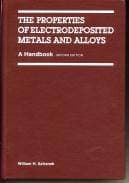
Curated with aloha by
Ted Mooney, P.E. RET

The authoritative public forum
for Metal Finishing 1989-2025

-----
Cadmium Density vs. Plating Speed
Q. Hello Folks, Can anyone tell me if there is a correlation between plating speed and density of deposition of cadmium? We are using an alkali cadmium cyanide bath, with nickel sulphate added as brightener. I ask this as i want to understand the correlation between coating density and the likelihood hydrogen embrittlement of test pieces. Thanks and best regards,
Mark Lees- A bright and shining rock in the Irish Sea
November 12, 2024
by William Safranek

on eBay or
AbeBooks
or Amazon
(affil links)
A. Hi Mark.
I'm not aware of much literature on that subject, and after brighteners have been brought into play I'm not sure that plating speed has that much influence anymore.
However, Safranek says "a cyanide solution with no organic additives or contamination is used at high current densities to produce a porous deposit." ⇨
He references MIL-STD-870 and an article by G.T. Sink, "A Low Embrittlement Cadmium Plating Process" from Plating Vol. 55, p. 449-455, 1968.
Luck & Regards,

Ted Mooney, P.E. RET
Striving to live Aloha
finishing.com - Pine Beach, New Jersey
Q. Thanks Ted, We have been getting a few ASTM F519 embrittlement failures.
And i am trying to understand why. I read an article suggesting that porosity of the cadmium can determine the hydrogen embrittlement, as a less porous surface traps more of the hydrogen from plating. Also, lower plating efficiency seems to lead to this via lower current densities.
I am still experimenting with the help of our platers, with it taking up to 10 days to get an answer from the F519 test as whether we are going in the right direction.
Best regards
Mark
- A rainy rock in the Irish sea
November 15, 2024
A. Hi again. I could be misunderstanding, but I believe that you are right, that you want porosity to allow the hydrogen to more easily leave upon baking, and that higher current densities result in lower efficiency and more porosity. So just short of burning is probably the best current density -- which seems to be what Safranek is saying.
Luck & Regards,

Ted Mooney, P.E. RET
Striving to live Aloha
finishing.com - Pine Beach, New Jersey
Q, A, or Comment on THIS thread -or- Start a NEW Thread